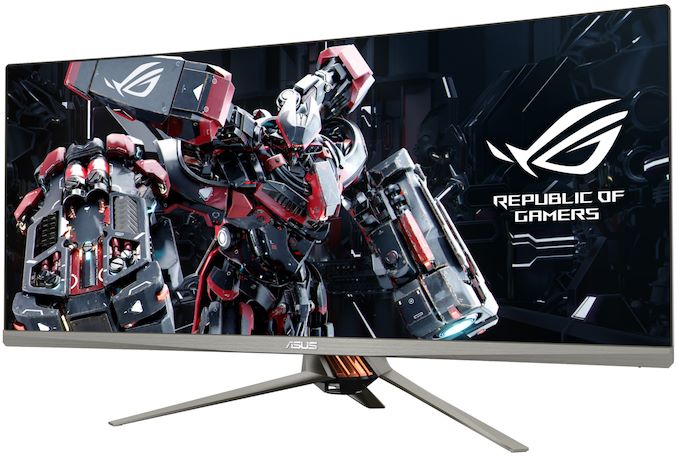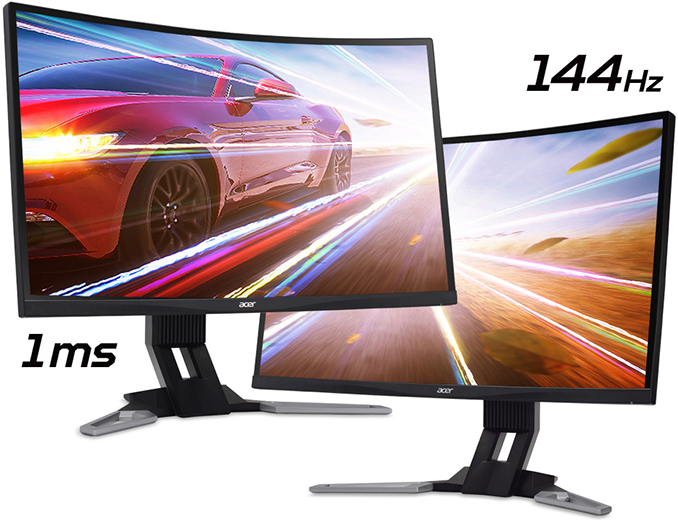Sales of High Refresh Gaming Displays Skyrocketing, Curved Gaming LCDs Prevail
by Anton Shilov on December 7, 2018 2:00 PM EST- Posted in
- Displays
- Acer
- Samsung
- Asus
- BenQ
- AOC
- Monitors
- Market Trends
- Philips
- Curved Display

The number of news stories about gaming displays that we post has increased significantly in the past couple of years. Established suppliers have broadened their lineups of gaming LCDs, and meanwhile new players have decided to join the party. Apparently, our coverage has been reflecting market sales trends, as sales of such monitors have been increasing at a rapid pace. According to WitsView, shipments of displays with a 100 Hz refresh rate or higher (i.e., gaming LCDs) will exceed five million units in 2018. Moreover, over half of them will be curved monitors.
Curved Gaming LCDs Leave Flat Displays Behind
Global sales of gaming displays with high refresh rates are expected to reach 5.1 million units in 2018, an annual growth of 100%, reports WitsView, a division of TrendForce. This is still a small fraction of the 126 million total LCDs projected to be sold in 2018 (up 1.5% year-over-year), according to the company. The researchers attribute the growing demand for displays with high refresh rates to recommendations from game developers, with groups such as the PlayerUnknown's Battlegrounds devs recommended 144 Hz+ displays. Meanwhile, it is evident that as the number of available models on the market is increasing, their prices are getting lower and gamers are more inclined to buy them.
One interesting point about gaming displays in general is that 54% of gaming LCDs sold this year will be curved monitors, leaving only 46% of them to be flat. Last year 77% of gaming displays were flat and only 23% were curved, according to WitsView. Shipments of around 2.75 million units is a big win for curved LCDs at large. In fact, keeping in mind that there are even more numerous curved models with refresh rates below 100 Hz, it is safe to say that sales of such displays in general will clearly surpass 5 million units, up from around a million in 2015. Since price difference between curved and flat monitors is diminishing, curved displays are no longer penalized with a price premium.
ASUS Leading the Pack
When it comes to suppliers of gaming displays, ASUS has been leading the pack for quite a while now, and this year was no exception. Acer maintained its second spot in 2018. By contrast, BenQ left the Top 4 and the third place now belongs to TPV, which sells products under AOC and Philips brands and is particularly successful in the Chinese, European, and APAC markets. Samsung moved up to fourth place (from the No. 5 spot) after expanding its gaming lineup with numerous new models in 2017 – 2018 timeframe, including the world’s first FreeSync 2-supporting monitors and numerous curved models of various sizes. It is noteworthy that 95% of Samsung’s gaming displays are curved.
| Top Suppliers of Gaming LCDs in 2017 - 2018 Data by WitsView, December 2018 |
|||
| Ranking | 2017 | 2018 Estimation |
|
| 1 | ASUS | ASUS | |
| 2 | Acer | Acer | |
| 3 | BenQ | AOC/Philips | |
| 4 | AOC/Philips | Samsung | |
| Shipments | 2.5 million | 5.1 million | |
Other vendors with impressive sales growth in 2018 noted by WitsView are MSI, HKC, and SDC. The latter two are particularly successful in China, whereas MSI is promoting its Optix gaming displays globally. Meanwhile, general LCD market leaders like Dell, HP, Lenovo, and LG are not exactly among the frontrunners on the market of gaming monitors.
| Top LCD Suppliers: 2017 - 2018 Data by WitsView, October 2018 |
|||||||
| 2017 | 2018 (Estimated) |
||||||
| Ranking | Brand | Market Share | Ranking | Brand | Market Share | ||
| 1 | Dell | 18.5% | 1 | Dell | 19.6% | ||
| 2 | AOC/Philips | 13.5% | 2 | HP | 13.8% | ||
| 3 | HP | 12.7% | 3 | AOC/Philips | 13.1% | ||
| 4 | Lenovo | 9.8% | 4 | Lenovo | 9.6% | ||
| 5 | Samsung | 9.6% | 5 | LG | 8.7% | ||
| 6 | LG | 9.3% | 6 | Samsung | 7.6% | ||
| 7 | Acer | 6.0% | 7 | Acer | 6.8% | ||
| Others | - | 20.5% | Others | - | 20.8% | ||
| Shipments | - | 123.7 million | Shipments | - | 125.6 million | ||
Related Reading:
- Acer Unveils KG1 Displays with Sub-1ms Response Time
- ASUS Lists ROG Strix XG32VQR Curved FreeSync 2 Display with RGB
- JapanNext Launches 35-Inch "UWHD" Curved LCD: AMVA & 200Hz Refresh w/FreeSync
- MSI’s 49” Optix Curved Display and Oculux 25” High Refresh Monitors Announced
- ASUS Announces ROG Strix XG32VQ and ROG Strix XG35VQ: Large, Curved, & Fast
- Smooth As 240 Hz Butter: LG's 27GK750F-B, a 27-inch eSports Monitor with FreeSync, Launched for $550
- BenQ Announces ZOWIE XL2546 ‘eSports’ Display: 24'', FHD, 240 Hz, DyAc ULMB Tech
Source: WitsView/TrendForce











75 Comments
View All Comments
GreenReaper - Friday, December 7, 2018 - link
Well, the trend is clear: eventually it'll just be a circle around your head. VR was just ahead of its time.Opencg - Saturday, December 8, 2018 - link
Probably not due to issues with rendering techniquesrocky12345 - Friday, December 7, 2018 - link
Then if you had a 22-26 inch Sony Trinitron CRT Monitor they were pretty much flat so maybe they were ahead of their time...:) I remember the most annoying thing with any Sony Trinitron or if any other company used Sony's tubes there were those 2 lines that showed up about a 3rd of the screen top and bottom I think they were some kind of guides of sorts but annoying just the same once you spotted them the first time your eyes would always go to either of the spots every time you used the monitor. Well at least mine did and I think most people did not even notice they were there. But the good was they almost always had a much sharper picture than most other CRT's of the time and looked good no matter what res you ran them in unlike the LCD's of today where they only look good in their native res. Then again I would rather pack around a 32 inch LCD monitor of today than a Sony Trinitron CRT 24 inch like I had back in the day because OMG the thing was heavy and the tube/back panel went on forever behind the screen...lolabufrejoval - Sunday, December 9, 2018 - link
The Trinitron displays tried to increase the active light emitting surface of the display by reducing the area taken up by the shadow mask required for color separation, essentially removing all horizontal barriers and using vertical slits instead. So first you have hundreds of vertial wires to split the hundreds of dots on each line into RGB.But when the display gets to be a little bigger, it's far to easy for these vertical wires to go out of alignment which is why they were then fixed with one or two vertical Tungsten wires (depending on display size), which essentially replaced the hundreds of vertical bridges a shadow mask would have used and covered up.
You were just sitting to close or "holding it wrong" and I guess you're also the type that complains about pentile dots on OLED screens: Please just use the shadow mask TV or LCD panel and stop bothering those of us who simply enjoy bright things!
Spunjji - Monday, December 10, 2018 - link
the technical part of your comment was great, but why the judgement? Some of us see things others don't. I love my OnePlus 6 but I notice the Pentile layout frequently, especially with black text on a white display. It's notably inferior to a standard RGB layout but for the money, I can deal.abufrejoval - Monday, December 10, 2018 - link
Thank you!Well the "judgement" was meant to be somewhat "tounge-in-cheek" or ironical: True miracles are really just very hard to achieve...
So engineers do try their best to deliver more lux per square millimeter and it just means that something has got to give, when you push things beyond normal.
For Trinitron it required the stabilizing wires and for the OLEDs it meant giving blue dots extra surface area to compensate for their relative weakness and early degradation, which the engineers could not fix, only compensate in a way the vast majority of people wouldn't notice.... unless they are extra sensitive, or concentrate hard on discovering the imperfection.
As in your case it really becomes a matter of accepting or not the compromise that needed to be made.
Lord of the Bored - Friday, December 7, 2018 - link
Gone from curved away to flat to curved forward. Next up the screen wraps around itself into a ball.nathanddrews - Monday, December 10, 2018 - link
You mean wrap it around your head? Like a VR helmet? Or maybe a holodeck?HStewart - Friday, December 7, 2018 - link
I am surprise Samsung and LG are low on the list. But I think Dell and HP are high on list because of business and some customer related purposes.Also don't think that all external monitors go to desktop monitor. I personal almost all the time use
external monitors - and for development - I use 2 externals on laptop.
I love my curved LG34U88
GreenReaper - Friday, December 7, 2018 - link
Same here. One HDMI, one DisplayLink USB for chat (pro tip: raise its user-mode driver process to Realtime priority). My Surface Pro has a separate one too, via DisplayPort - good for multiple streams.